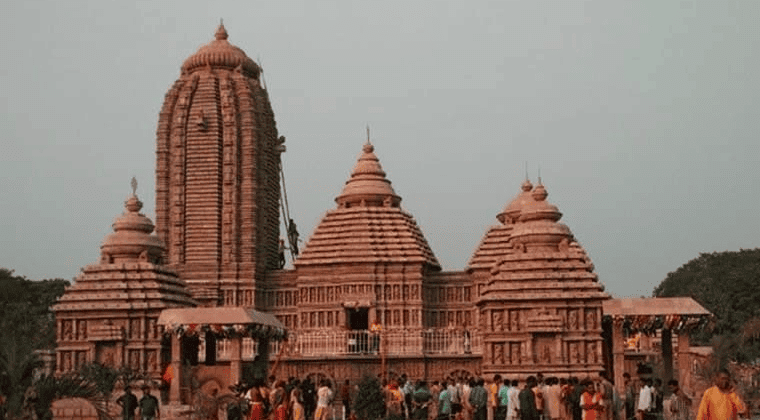Temple Architecture: Odisha | History Optional for UPSC PDF Download
| Table of contents |

|
| Introduction |

|
| Characteristics |

|
| Khakhara Deula |

|
| Sun Temple- Konark (also called Black Pagoda) |

|
Introduction
Odisha Temple Architecture (Kalinga Architecture), also known as Eastern Ganga Style, was predominantly constructed between 750 AD and 1250 AD by the Eastern Gangas. This architectural style can be divided into three distinct phases:

Phase I: 750-900 ADImportant temples from this phase include:
- Lakshmaneshwar Temple
- Bhuvaneshwar Temple
- Ishwareshwar Temple
Phase II: 900-1100 ADNotable temples from this period are:
- Lingaraj Temple in Bhubaneswar
- Jagannath Temple in Puri
- Puri Temple(also known as the White Pagoda)
Phase III: 1100-1250 ADKey temples from this era include:
- Raja Rani Temple in Bhubaneswar
- Anant Vasudeva Temple in Bhubaneswar
- Sun Temple in Konark (the largest and latest, also known as the Black Pagoda)
Characteristics
Ground Plan and Vertical Division:
- The temple has a square ground plan with
graduated projections on each side, giving it a cruciform shape. - It features vertical divisions called Rathas, which include different types like Trirathas, Pancharathas, and Saptarathas.
Main Temple:
- The main temple consists of the Garbha Griha(sanctum) and Shikhara(spire).
- In Odishan architecture, the Garbha Griha is known as Deul or Srimandir, and the Shikhara is called Rekha Deul.
Other Parts of the Temple:
Besides the main temple, there are three other components:
- Mandap called Jagamohan
- Dancing Hall called Nat Mandir
- Offering Hall called Bhog Mandir
The structures of these parts differ from the Rekha Deul, featuring a pyramidal-shaped roof known as Pida Deul.
- Odissan architecture does not include an ardha Mandapa.
- Temples may have different combinations of these parts, such as only Rekha Deul, Rekha Deul and Jagamohan, or all four parts.
- Examples of temples with all four parts include Lingraj temple and Anant Vasudeva temple.
Khakhara Deula
- Design Similarity: The Khakhara Deula style resembles the Dravidian Gopuran design.
- Roof Structure: It features a barrel-vaulted elongated roof with a truncated pyramid shape, akin to gopuras.
- Common Examples: Sakta temples, such as the Brahmi temple, Varahi Deula in Chaurasi (Puri district), Gouri temple in Bhubaneswar, and Baitala Deula in Bhubaneswar.
- Pillars and Piers: Unlike typical Odishan temples with no pillars, these temples have piers, which are pillars attached to walls.
- Hall Design: The halls are closed types, providing a distinct interior space.
- Wall Treatments: Interior walls are generally plain, while exterior walls are ornamented and decorated.
- Ornamentation: Exterior decorations include images of deities, sculptures of sacred and popular animals, human figures like dancers, musicians, and erotic figures.
- Notable Temples: Examples include Lingaraja Temple in Bhubaneswar, Lingraj Temple in Khordha, Anant Vasudeva Temple, Varahi Devi Temple in Chaurasi, Varahi Deula, Vaitala Mandira, and Baitala Deula.
Sun Temple- Konark (also called Black Pagoda)

- The temple, built around 1250 CE, is credited to King Narasingha Deva I of the Eastern Ganga Dynasty.
- It is the largest and most recent of the Odishan temples.
- Three main parts:
- Deul: The sanctum or main shrine.
- Jagmohan: The hall in front of the sanctum.
- Natmandir: A pillared pavilion.
- The temple is surrounded by an enclosure with Torans(ornamental entrance arches).
- The structure is designed to resemble a gigantic Sun Chariot, featuring 12 pairs of wheels.
- The wheels are spoked, with 8 broad and 8 thin spokes.
- The temple is adorned with various sculptures, including erotic figures and free-standing animals.
|
367 videos|995 docs
|
FAQs on Temple Architecture: Odisha - History Optional for UPSC
| 1. खाखरा देवला क्या है और इसकी विशेषताएँ क्या हैं? |  |
| 2. कोणार्क सूर्य मंदिर का महत्व क्या है? |  |
| 3. ओडिशा के मंदिर वास्तुकला की विशेषताएँ क्या हैं? |  |
| 4. कोणार्क सूर्य मंदिर का निर्माण किसने किया था? |  |
| 5. खाखरा देवला की स्थापत्य शैली को कैसे पहचाना जा सकता है? |  |














